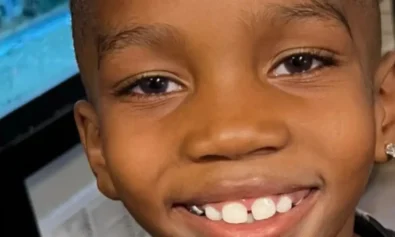One day in 2015, Harmony Ilunga, then a 16-year-old high school student and aspiring model, walked out of a modeling agency and broke down in the bustling, cosmopolitan streets of Hong Kong.
Ilunga knew she wanted to be a model from a very young age.
“If you look at some of my photos from when I was 5 or 8, you can clearly tell that I knew I wanted to be a model,” she told Atlanta Black Star.

Despite repeated endeavors to get a modeling agency to represent her, she was being turned away. The problem was her skin color.
Ilunga arrived as a refugee from the Democratic Republic of Congo in 2011 and spent her formative years in Hong Kong. The 25-year-old barely remembers her life back in Congo. As far as she was concerned, she was a Hong Konger. But from the Asian perspective of beauty standards, she didn’t fit in.
“This lady [from a modeling agency] literally told me that they don’t hire Black models. And another one, they said, ‘Oh, you’re not what the clients are looking for.’ Another comment was from somebody who is a fashion brand designer, who told me that she works with clients who said, ‘When you use a Black model, it looks cheap. Your brand looks cheap,’” said Ilunga.
As an impressionable teenager excited to pursue her dreams, these comments had a tremendous psychological impact. She started buying and using cosmetic bleaching products from the market.
“If you look at my high school photos, I was super pale. I was using skin-lightening products to meet the beauty standards they were looking for,” she said.
Even then, she found it hard to land paid modeling gigs. Throughout high school, she struggled. She modeled for free for almost three years to have a shot at her dream.
“I started by helping my friend’s sister. Then, some people were looking for models to start their own fashion brands, and they needed a Black model,” she said.
The first time she got paid was a paltry HK$100 for someone’s school project, but it was a significant milestone for Ilunga. Slowly, as she made her way through the local fashion scene and with the help of friends’ recommendations, she started getting paid for her work.
Hong Kong’s Fashion Evolution
According to the latest projections, the revenue of the Hong Kong fashion market is expected to reach a staggering US$9.23 billion by 2024.
Moreover, the market is anticipated to grow at an even more astounding rate, reaching a market volume of US$15 billion by 2029. It is estimated that the number of fashion market users in the region will also witness a significant increase, reaching 5.6 million by 2029.
Veteran fashion photographer and multimedia artist John-Paul Pietrus worked for Shanghai Tang, a Hong Kong-based luxury fashion house.
“In my personal experience, Hong Kong’s fashion media has, generally speaking, been a follower rather than a leader. Therefore, when it comes to black model presence in the media there, it has been next to none, from my observation. I did shoot Rob Evans for the Manifesto magazine cover back in 2013, but I would say it is a rare occasion,” Pietrus said.
Rise of China
In 1997, before the British government handed over Hong Kong to China, both countries agreed to respect the region’s political autonomy for fifty years under a framework called “one country, two systems.” Beijing had agreed to allow Hong Kong to maintain its capitalist system and enjoy numerous freedoms not available in mainland Chinese cities, giving the city 50 years to transition.
Despite its fashion evolution, Hong Kong now faces stiff competition from mainland China. The zero-Covid policy has prevented many travelers from coming to Hong Kong, which has cut off a significant portion of luxury spending.
According to a report released by the consulting firm PwC in February 2023, before the pandemic, Hong Kong was viewed as a more westernized and accessible destination than mainland China, making it attractive to luxury brands.
However, in 2021, the spotlight shifted to mainland China, with 55 percent of the world’s new luxury stores opening there.
“Back then [in the early 2000s], China was still developing its fashion voice, which is very developed now. There’s now a huge photographic, styling, and fashion community there. But at that time, it was still developing,” Pietrus said.
A Sino-African Fashion Influence
Compared to the US, China enjoys a very different dynamic with the Black diaspora and Africa.
Much of the Black population in China is either there for business or education.
Some of the first Africans to settle in Hong Kong arrived in the early 1990s to conduct business. Over time, they transitioned into becoming brokers for other African businesspeople seeking entry into the Hong Kong market. However, Hong Kong has not been as popular since China joined the World Trade Organization in 2001.
Despite these developments, as Ilunga’s experiences demonstrate, the Chinese fashion industry and the larger Chinese society weren’t keen on diversifying the talent pool. However, some unexpected positive developments occurred in the early 2010s thanks to the progressive vision of a few.
In 2012, Sudanese-Australian model Ajak Deng was the first Black model to grace the cover of a Chinese fashion publication, Modern Weekly.
“It was a huge sensation, partially because Ajak was the first Black model to be featured on the cover of an indigenous Chinese publication and because of her fantastic Comme des Garçons dress. It was quite a striking image and caused quite a stir,” said Pietrus, who had taken the pictures.
Establishing A Voice of Her Own
Meanwhile, after years of struggle, when Ilunga started getting booked by big brands, she recalls thinking for the first time that she could have a modeling career.
Still, modeling agencies were unwilling to sign her, so she worked freelance until 2020.
“Observing what was happening in the industry, I decided it was time to launch [a modeling agency]. I started [in 2018] by raising awareness by organizing a biannual fashion show at a club. I wanted to highlight the Hong Kong fashion scene and showcase the talents of refugees and ethnic minorities,” she said.
“We are being overlooked. I believe that actions speak louder than words, and I wanted to demonstrate the value that these diverse individuals can bring to society. Rather than simply speaking out or protesting, I planned to showcase their talents through a fashion show. These people were born in Hong Kong and can contribute to Hong Kong’s society,” she added.
In 2020, she launched her fashion agency, HarmonyHK, to further her efforts to promote inclusivity and diversity in the local fashion scene.
It currently represents 45 models.
“We have local Hong Kongers, mixed Black and Asians, Westerners, Indians, Pakistanis, Nepalese, Filipinos, and some Black models from Burundi. We also have plus-size models,” she said.
She primarily works with clients who sell Korean products in Japan and local Hong Kong brands.
The agency has collaborated with big brands like Fenty Beauty, Lululemon, and Esprit.
“I never knew or expected it to grow the way it did. I believe we’ve done a pretty good job,” she said.
The Impact of the Black Lives Matter Movement
The real changes started in the global fashion industry, including Greater China, after the Black Lives Matter movement gained ground in the U.S. as many cases of racially motivated violence against Black people by the police and non-Black citizens came to light. In 2020, however, with the murder of George Floyd by a police officer in full public view, the movement gained international attention.
For Pietrus, Floyd’s murder felt personal.
In early 1990, Pietrus was a student at the Minneapolis College of Art and Design in the Whittier neighborhood where George Floyd died. He recalled racial tensions between police and non-police, especially non-white people.
He was shocked the situation had hardly changed and that the racial tension between the police and non-white citizens persisted, culminating in the horrible and tragic death of George Floyd.
Suddenly, there was a huge demand for Black models, Ilunga said.
“I received many messages from people who just wanted to use me as a Black model to look like they were part of the movement. Because, you see, many brands were being questioned, ‘Oh, we never see you support Black models.’ So, many brands were jumping on and wanting to work with Black models,” she recalled.
However, she pointed out that many brands were entering the space without knowing how to navigate it properly.
HarmonyHK offers diversity and inclusion consultation because Ilunga believes it’s important to have somebody from this industry to guide them, explain how things are done, and ensure brands are not using Black models simply because everyone else is doing it at the time.
Things changed drastically in the Greater Chinese fashion industry.
At the time, HarmonyHK was the only local Black-owned and Black-led modeling agency focusing on diversity and inclusion.
“I think it was an eye-opening moment for many brands in Hong Kong to step further and be more inclusive in their brands because most of them also tend to sell in America. So, you have to have a representation of what people look like,” she said.
“I have to say, in the past decade I’ve lived in Hong Kong, that was when we were being seen,” she added.
She also received numerous messages from parents thanking her for sharing your story and her efforts to make the local fashion scene more inclusive.
“They said, ‘Thank you. My kids now feel seen,’” she said.
After the brutal daylight murder of Floyd, a lot of brands made promises and pledges and instituted diversity programs. However, Ilunga feels that the momentum subsided with time.
“[Local] Brands still employ models from ethnic minority communities like Black or half-Black, but the peak of change was in 2020 when #BlackLivesMatter was everywhere. Since then, things have cooled down,” she explained.
Having worked in the industry for some time now, Ilunga has noticed that Asian brands that target the West tend to use a more inclusive and diverse range of models.
“The brands that are targeting Asian markets, they are not inclusive,” she explained.
Pietrus noted that as far as diversity is concerned, China is currently very China-centric.
“If you’re of any ethnicity besides Chinese, it may be difficult to work for a Chinese brand because they’re looking towards their own culture right now when hiring models and talent,” he said.
Change and Challenge
Despite the lingering problems, Ilunga is glad that Hong Kong is now open to conversations.
“That’s a step in the right direction. We can start slowly; we can’t expect people to change all at once, but at least having this conversation is a big step,” she said.
Right now the model and entrepreneur Ilunga is based in Toronto, Canada, working on a new tech startup that aims to coexist with HarmonyHK and grow her business between the West and the East.
“Hong Kong is heavily influenced by Western culture. So, when I got permanent residency in Canada, I decided it was time to expand HarmonyHK beyond Hong Kong,” she said.
She is not currently recruiting models for her agency but plans to start soon. Ilunga plans to travel between Hong Kong and Canada to grow their network.
The situation has changed considerably since Ilunga started modeling, but she admits there’s room for improvement. She still feels some resistance regarding public perception but admits the situation has improved.
“There are still reservations, but it’s not like before. That’s something I can be very honest about,” she said.


